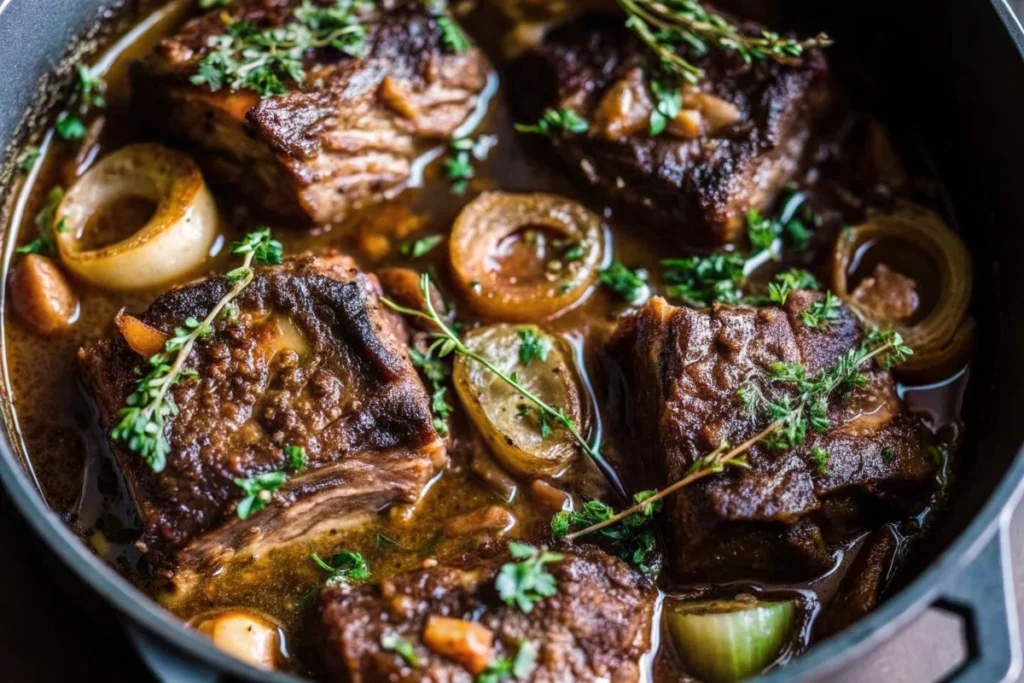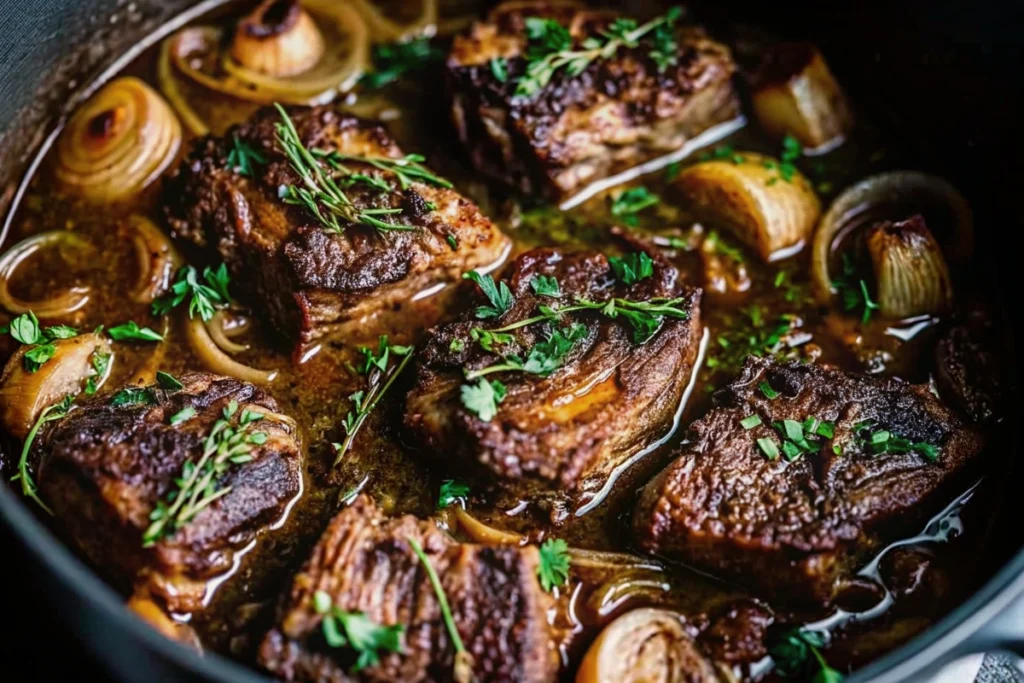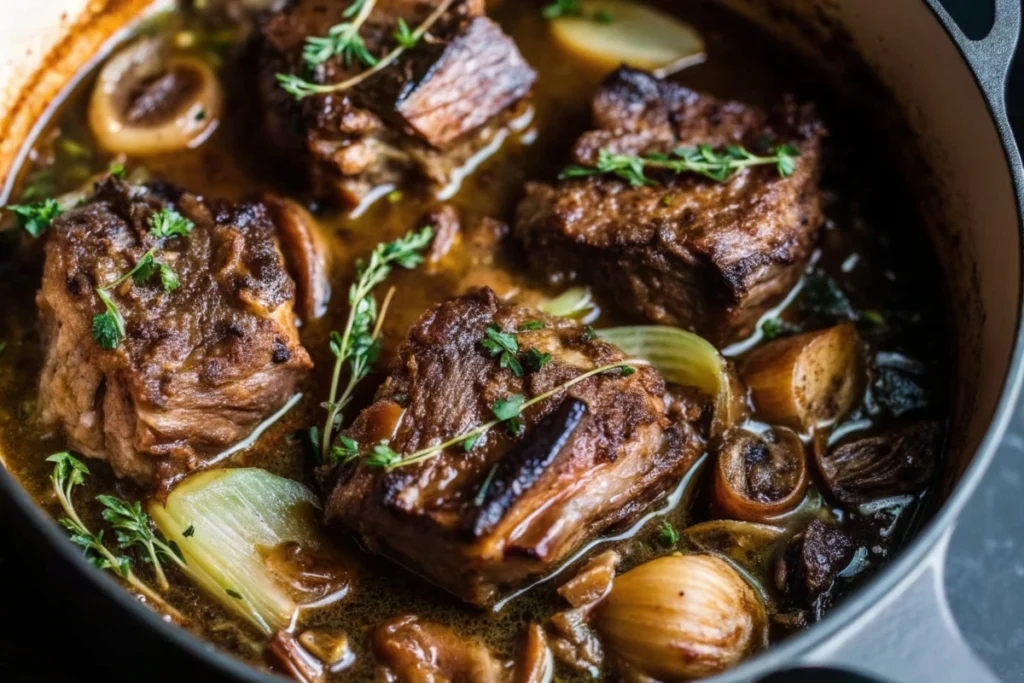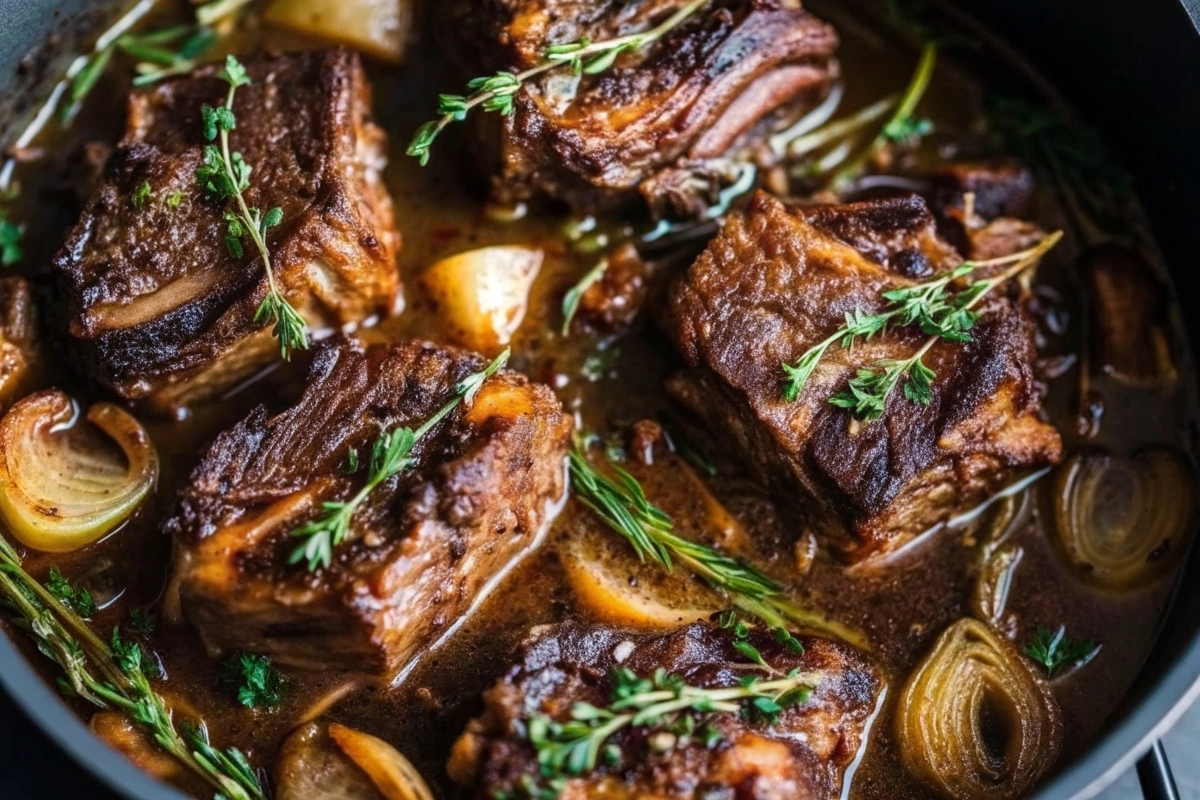Belgian-Style Slow-Cooked Beef Stew: A Culinary Masterpiece
Discover the soulful depth and rich flavor of a true Belgian classic—Belgian-Style Slow-Cooked Beef Stew. This article is crafted for those who appreciate hearty cooking techniques and celebrate authentic European traditions through the art of slow-cooked meals. In the following sections, you’ll explore its history, master the art of the slow-cook, and learn how to create a dish that bursts with flavor and character.
Introduction
Belgian-Style Slow-Cooked Beef Stew is more than just a meal; it is a celebration of tradition and craftsmanship passed down through generations in Belgium. This timeless dish, often celebrated for its tender beef and delectable infusion of Belgian ale and aromatic spices, represents the soul of rustic European cooking.
- Key Characteristics:
- Slow-cooked to perfection for maximum tenderness and depth of flavor
- Incorporates a blend of Belgian influences and artisanal cooking techniques
- Perfectly balanced with spices that evoke centuries of culinary heritage
To delve into the intricate origins and cultural significance of this dish, consider learning more about Belgian Culinary Traditions to appreciate the regional influences that have shaped its evolution.
A Journey Through History and Tradition
Tracing the roots of Belgian-Style Slow-Cooked Beef Stew takes us on a fascinating historical journey through Belgium’s rich culinary landscape. From the medieval kitchens to modern-day family feasts, this beef stew has evolved while retaining its core identity as a hearty and robust meal.
- Historical Backdrop:
- Originated in rural regions where slow-cooking was a natural method to transform tough cuts of beef into tender delights.
- Over the centuries, regional variants emerged, each adding unique twists influenced by local ingredients and traditions.
- Renowned alongside other European stews, such as Carbonnade Flamande and beef bourguignon, it has maintained its individuality through distinctive flavors and preparation methods.
In the vibrant culinary realm of Belgium, historical recipes merge with modern techniques—an influence echoed in resources like Slow-Cooking Tips for Crab-Stuffed Beef Tenderloin. Here, you can explore the evolution of cooking methods that have enriched traditional recipes, lending an air of authenticity to contemporary interpretations of classic stews.
- Cultural Significance:
- A staple during winter months and special gatherings, the Belgian beef stew brings families and friends together.
- It represents a practical use of available local produce and meats, turning humble ingredients into a dish celebrated for its warmth and complexity.
- Over time, regional stories and family secrets have been passed on, ensuring that every bowl of stew carries with it a narrative of heritage and community.
Key Ingredients and Their Roles
At the heart of an exceptional Belgian-Style Slow-Cooked Beef Stew lies the careful selection and harmonious combination of ingredients. Each component is chosen to maximize flavor and ensure that the slow-cooking process creates a dish with unmatched depth and authenticity.
- Meat Selection:
- Beef Cuts:
The stew requires cuts that are rich in connective tissue, such as chuck or brisket, which break down over time to achieve that irresistible tenderness. - Why These Cuts?
- They deliver a melt-in-your-mouth texture.
- The natural fat and collagen infuse the stew with a luxurious mouthfeel that transforms every bite into a comforting experience.
- Beef Cuts:
- Signature Ingredients:
- Belgian Ale:
A key ingredient, Belgian ale infuses the stew with subtle bitter and malty notes, balancing the savory richness of the beef. - Aromatic Vegetables:
Traditional vegetables like onions, carrots, and celery are essential, not only for their flavor contributions but also for the texture they add to the dish. - Herbs and Spices:
A blend of thyme, bay leaves, and mustard seeds is conventionally used to accentuate the flavors of the meat. - Optional Enhancements:
- A touch of dark chocolate or a sprinkle of brown sugar can be used to round out the flavors.
- A dash of vinegar or a squeeze of lemon may be included to provide a subtle acidity that cuts through the richness.
- Belgian Ale:
- Cooking Liquids:
- Combining Belgian ale with a quality beef stock or broth creates a dynamic foundation for the stew, ensuring each ingredient has room to shine during the lengthy cooking process.

By understanding the role of each ingredient, you can appreciate how a simple selection of components transforms into a multi-layered symphony of taste when given the time to blend and mature.
The Art and Science of Slow Cooking
The transformative process of slow-cooking is an art that elevates a traditional beef stew into a culinary masterpiece. This method relies on patience and precise control of heat and timing, ensuring the flavors meld beautifully over several hours.
- Benefits of Slow Cooking:
- Tenderness Beyond Compare:
The low and slow method breaks down the collagen in tougher cuts, leading to exquisitely tender beef. - Enhanced Flavor Profiles:
Long cooking times allow spices and herbs to deeply infuse the meat and liquid, creating a complex flavor layered with hints of Belgian ale and wood-fired charm. - Simplified Process:
Once the ingredients are set on low heat, the stew requires minimal attention, allowing the natural magic of the slow-cooking process to work its wonders.
- Tenderness Beyond Compare:
- Techniques for Success:
- Browning the Beef:
- Begin by searing the beef in batches to develop a caramelized crust that locks in the juices.
- This step is crucial for adding a depth of flavor that simply cannot be achieved by slow-cooking alone.
- Deglazing and Simmering:
- Deglaze the pan with Belgian ale or broth after browning to capture all the flavors stuck to the bottom.
- Allow the liquid to simmer with a combination of herbs and aromatics that further enrich the stew.
- Temperature and Time:
Maintaining a stable low temperature (typically between 275°F and 300°F) is critical. The beef should ideally cook for 3 to 5 hours, depending on the cut and desired tenderness.
- Browning the Beef:
- Practical Tips:
- Layering Flavors:
Add ingredients in stages to build up flavor: start with the beef, then incorporate vegetables, and finally, the liquids and herbs. - Use of Slow Cookers vs. Ovens:
- Slow Cooker: Ideal for hands-off cooking, preserving moisture and flavor over extended periods.
- Oven Method: Offers a controlled heat environment that some chefs prefer for achieving a slightly caramelized finish.
- Monitoring Progress:
Check intermittently to ensure the stew is not drying out; if needed, add extra liquid to maintain the perfect consistency.
- Layering Flavors:
This method not only results in a visually appealing dish with aromatic steam rising from the pot but also serves as a testament to the enduring beauty of traditional slow-cooking. Every step, from the initial sear to the final simmer, contributes to an experience that is both satisfying and steeped in history.
Step-by-Step Recipe Guide
Crafting a perfect Belgian-Style Slow-Cooked Beef Stew at home is a rewarding journey that balances preparation, patience, and precise technique. Follow these detailed steps to create a stew that promises a symphony of flavors with every bite.
Ingredients
- Beef and Marinade:
- 2–3 lbs of beef chuck or brisket, cut into 1.5-inch cubes
- Salt and freshly ground black pepper
- 2 tablespoons of olive oil
- Vegetables:
- 2 large onions, roughly chopped
- 4 medium carrots, peeled and cut into bite-sized pieces
- 3 celery stalks, sliced diagonally
- Aromatics and Herbs:
- 3 cloves garlic, minced
- 2 bay leaves
- 4 sprigs of thyme
- Liquids and Flavor Enhancers:
- 1 bottle of Belgian ale
- 2 cups of beef stock or broth
- 1 tablespoon of Dijon mustard
- 1 tablespoon of brown sugar (optional, for a hint of sweetness)
- A splash of vinegar or lemon juice (to brighten the flavors)
Instructions
- Preheat & Prepare:
- Preheat your oven to 300°F if using the oven method.
- Season the beef cubes generously with salt and pepper.
- Browning the Beef:
- In a large, heavy-bottomed pot or Dutch oven, heat the olive oil over medium-high heat.
- Add the beef in batches, ensuring not to overcrowd the pot. Brown all sides until a crust forms, then remove and set aside.
- Bullet Points:
- Brown in batches to maintain high heat.
- Ensure each piece has a crispy exterior.
- Pro tip: Reserve the fond (browned bits) in the pot—they are full of flavor!
- Vegetable Sauté:
- In the same pot, add the chopped onions, carrots, and celery.
- Sauté until the onions become translucent and the vegetables begin to soften.
- Stir in the minced garlic and let it cook until fragrant.
- Bullet Points:
- Sautéing vegetables helps to build the base flavor.
- Ensure even cooking by stirring occasionally.
- Deglazing the Pot:
- Pour in a small amount of Belgian ale or beef stock to deglaze, scraping the bottom of the pot to incorporate the brown bits.
- Allow the liquid to simmer briefly to reduce slightly.
- Bullet Points:
- Deglazing captures all the flavor locked in the fond.
- This step ensures a robust and layered sauce.
- Combining Ingredients:
- Return the browned beef to the pot.
- Add the remaining Belgian ale, beef stock, Dijon mustard, bay leaves, and thyme.
- Stir gently to combine, ensuring the beef and vegetables are evenly distributed in the liquid.
- Bullet Points:
- Layer the beef and vegetables for better flavor integration.
- Maintain a gentle stir to avoid breaking down the beef too much.
- Slow-Cooking Process:
- Oven Method: Cover the pot with a tight-fitting lid and place it in the oven for 3-5 hours, checking occasionally to ensure the liquid level remains sufficient.
- Slow Cooker Method: Transfer all ingredients to a slow cooker on low heat and cook for a similar duration.
- Periodically check the stew, stirring lightly to redistribute flavors.
- Bullet Points:
- Patience is key—allow the flavors to meld over hours.
- Low and slow cooking transforms tougher cuts into succulent, tender meat.
- Final Adjustments:
- Once the beef is meltingly tender and the sauce has thickened to your liking, remove the bay leaves and thyme sprigs.
- Adjust the seasoning with salt and pepper if necessary.
- For those who prefer a slightly sweeter finish, stir in a touch of brown sugar during the last 15 minutes of cooking.
- Serving the Stew:
- Ladle the stew into bowls, ensuring each serving is packed with meat and vegetables.
- Garnish with a sprinkle of chopped fresh parsley for a pop of color.
- Serve alongside crusty bread or traditional Belgian fries for a complete meal experience.

This recipe is a testament to the beauty of slow-cooked cuisine and the rich culinary heritage of Belgium. Each step is designed to harness the deep flavors locked within every ingredient, ensuring that every spoonful of this stew exudes comfort and authenticity.
Exploring Variations and Customizations
While the traditional Belgian-Style Slow-Cooked Beef Stew holds a special place in culinary tradition, there is ample room for personalization. Experimenting with variations allows you to adjust the dish to your taste while preserving its fundamental character.
- Regional Twists:
- Flemish Inspirations:
- Consider incorporating elements from Carbonnade Flamande, another beloved Flemish stew, by adding a slight reduction in sweetness or an extra dash of mustard.
- Herb-Forward Versions:
- Increase the concentration of fresh thyme and rosemary for an herbaceous twist.
- Bullet Points:
- Tailor the stew by varying the ratio of Belgian ale to beef stock.
- Experiment with additional aromatics like leeks or parsnips for subtle complexity.
- Flemish Inspirations:
- Dietary and Flavor Adaptations:
- Low-Sodium Alternatives:
- Substitute standard beef stock with a lower-sodium version if desired.
- Use a mix of water and concentrated stock to adjust the salt levels carefully.
- Extra Vegetables:
- Enrich the stew by adding mushrooms, turnips, or even parsnips during the final stages of the cooking.
- Bullet Points:
- Enhance the dish with seasonal vegetables for a unique twist.
- Always taste and adjust seasoning gradually to suit your palate.
- Low-Sodium Alternatives:
- Adding Personal Flair:
- Encourage creative modifications that do not stray too far from the established flavor profile.
- Highlight your culinary journey by noting any creative changes made to the recipe, ensuring that your version retains the hearty heart of the Belgian-Style Slow-Cooked Beef Stew.
These variations not only honor tradition but also invite you to explore different facets of flavor, turning each cooking session into a delightful experiment in slow-cooked excellence.
Serving, Presentation, and Pairings
The final presentation of Belgian-Style Slow-Cooked Beef Stew is as important as the cooking process itself. Thoughtful plating, combined with complementary side dishes, can elevate the dining experience and enhance the stew’s rustic charm.
- Plating and Presentation:
- Garnishes:
- A sprinkling of fresh parsley or chives adds a burst of color.
- A drizzle of reduced sauce or a few croutons can add texture.
- Serving Suggestions:
- Serve the stew in a rustic bowl to highlight its hearty character.
- Pair it with a side of crusty bread or Belgian fries to sop up every delicious drop.
- Bullet Points:
- Use a deep bowl to showcase the abundant layers of meat and vegetables.
- Enhance visual appeal with contrasting garnishes for a balanced look.
- Garnishes:
- Beverage Pairings:
- While the stew stands robust on its own, pairing it with a carefully chosen beverage can elevate the meal experience.
- Consider a glass of Belgian ale or a bold red wine that complements the deep flavors of the stew.
- Bullet Points:
- Opt for drinks that mirror the smoky and malty notes in the stew.
- Ensure that the beverage selection enhances rather than overwhelms the natural flavors.
This attention to serving and presentation not only makes the meal visually enticing but also turns it into a holistic dining experience where every element—from the spoonful of stew to the crunch of fresh bread—speaks of quality and tradition.

Frequently Asked Questions (FAQs)
Here are some of the most common questions asked by culinary enthusiasts regarding this robust dish:
- What makes Belgian-Style Slow-Cooked Beef Stew so unique?
- Its unique blend of Belgian ale, slow-cooked beef, and aromatic herbs distinguishes it from other traditional stews.
- Can I substitute the type of beef used?
- Yes, while cuts like chuck or brisket are recommended, other cuts may work if cooked slowly to render tender and flavorful results.
- How do I maintain the perfect consistency for the stew?
- Monitor the liquid level during cooking. If it becomes too thin, remove the lid near the end to allow reduction.
- Is it possible to create variations without compromising the traditional flavor?
- Absolutely. Small tweaks like adjusting the herbs or adding extra vegetables can personalize the dish without losing its heritage.
- What side dishes best complement this stew?
- Traditional choices include crusty bread, Belgian fries, or a light salad that balances the dish’s richness.
Final Thoughts and Conclusion
In conclusion, crafting the perfect Belgian-Style Slow-Cooked Beef Stew is a journey that weaves together history, tradition, and modern cooking techniques. The art of slow-cooking transforms simple ingredients into a luxurious feast of flavors that excites the palate and delights the senses.
- Summing Up:
- The stew’s complexity, enriched by Belgian ale, a careful selection of herbs, and the meticulously timed cooking process, is a testament to the dedication of Belgian cuisine.
- Every element of this dish, from the initial browning to the final simmer, reflects a rich cultural narrative that continues to evolve while staying true to its roots.
- Encouragement to Experiment:
- As you venture into making this stew at home, feel free to personalize it with slight modifications, ensuring your version retains the classic charm while showcasing your culinary flair.
- Creativity in the kitchen is what keeps traditional recipes alive and relevant for future generations.
- A Call to Share:
- Once you have perfected your version of the Belgian-Style Slow-Cooked Beef Stew, invite family and friends to share in the experience.
- Document your journey and the unique twists you introduce, as every variation is a tribute to the vibrant legacy of Belgian culinary traditions.
With these insights, tips, and a step-by-step guide, you’re now well-equipped to embark on the culinary adventure of preparing a stew that is as satisfying to create as it is to savor. Enjoy the process, embrace the history, and let every bite remind you of the cherished traditions that make slow-cooked dishes a timeless delight.


3 thoughts on “5 Irresistible Reasons to Love Belgian-Style Slow-Cooked Beef Stew: A Hearty Tradition of Flavor”